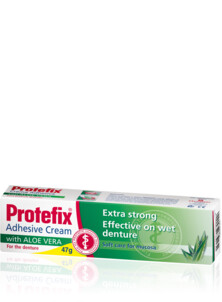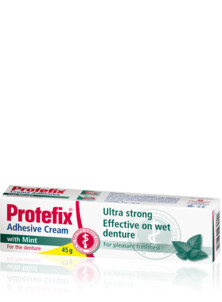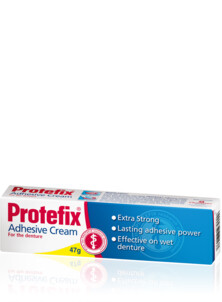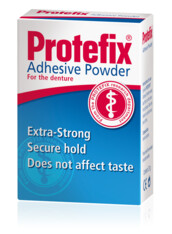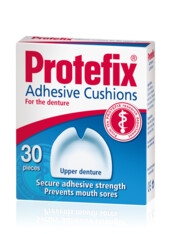
- What's the special active principle of Protefix Protect Gel?
- What's TGO?
- What can I do to get used to my new dentures faster?
- Why may I use Protefix Adhesive Cushions only if i'm wearing full dentures?
- What can I do when the nozzle of the Protefix Adhesive Cream tube is blocked?
- Will it harm me if I swallow Protefix Adhesive Cream?
- How long does the adhesive effect of Protefix Adhesive Cream?
- How can I remove any residues of the adhesive from my mouth and my dentures?
- How do I take my dentures out of my mouth?
- Will my dentures fit better if I use an adhesive?
- What kind of adhesion problems are Protefix Adhesive Cushions suited for?
- What kind of adhesion problems is ProtefixAdhesive Cream suited for?
- What kind of adhesion problems is Protefix Adhesive Powder suited for?
What's the special active principle of Protefix Protect Gel?
Protefix Protect Gel forms a protective barrier that adheres well even to moist mucosa, protecting the wound against chemical influences and the mechanical pressure of the dentures or bracket. This relieves pain and promotes the wound-healing process.
What's TGO?
TGO is the main ingredient of Protefix Protect Gel, a patent-protected active ingredient that adheres particularly well even on the moist mucosa. It is gained from special vegetable oils using a unique method and covers the affected areas in the mouth like a plaster.
What can I do to get used to my new dentures faster?
In the case that you've first been given interim dentures until your final dentures have been made, it's advisable to use Protefix Adhesive Cushions for this interim period. After the extraction of teeth, the jaw undergoes processes of rapid change, and even after just a few days the interim dentures won't fit any more. Here's where the adhesive cushions ensure a tight fit and also protect against spots and inflammations. In the entire accustomization phase, it's also advisable to use Protefix Protect Gel on a daily basis. Studies have shown that denture wearers who do this find it much easier to get used to their new dentures, because there is less irritation of the mucosa.
Why may I use Protefix Adhesive Cushions only if i'm wearing full dentures?
The fleece material of the adhesive cushions is made of a plastic material and doesn't dissove in the mouth. This makes it easy to remove the adhesive cushions from the full dentures for cleaning. In the case of partial dentures and dentures that are attached to single abutment teeth or jacket crowns, the fleece material can snag between the dentures and the abutment tooth or jacket crown. This may make it impossible to remove the dentures from the mouth without damaging them.
What can I do when the nozzle of the Protefix Adhesive Cream tube is blocked?
If too much cream collects in the tube nozzle, it can get clogged - especially when the adhesive cream comes into contact with moisture. This is why you should always keep the nozzle clean and dry, wiping off any residual cream with a tissue or cotton-wool bud. Please never rinse the tube nozzle under running water, since water results in the adhesive cream turning hard and forming a solid clot in the nozzle tip, thus making it impossible for you to press any more cream out of the tube.
Will it harm me if I swallow Protefix Adhesive Cream?
No. Protefix Adhesive Cream is slowly dissolved by saliva, so that swallowing small amounts of the cream will not cause harm. The main ingredients of the cream pass through the digestion tract unchanged. They are hence indigestible and have no appreciable effect on the human body.
How long does the adhesive effect of Protefix Adhesive Cream?
The adhesive power of Protefix Adhesive Cream can differ considerably from one person to the next. While one user study has shown that the average adhesion time of Protefix Adhesive Cream is between eight and ten hours, depending on the type of dentures and the jaw conditions the individual adhesion duration can deviate from this average time substantially.
How can I remove any residues of the adhesive from my mouth and my dentures?
The best way to remove any remaining adhesive from the dentures is using a toothbrush and toothpaste that doesn't contain too many "abrasives". Residues of adhesive in the mouth can be easily removed with oil. Either dip a cotton-wool bud in oil or go to a pharmacy to get a special "gum oil".
How do I take my dentures out of my mouth?
If you use an adhesive, you must break the seal between your gums and the adhesive.
- First rinse your mouth with warm water or mouthwater.
- Then pull gently on your lower dentures, shaling slightly until they come away.
- To remove your upper dentures, place your thumb behind the front teeth and then at the same time press upwards and outwards in the direction of your nose.
- If you still can't remove your dentures after following these tips and don't feel happy with wearing them overnight, you can go to the A&E unit of your local hospital or turn to the duty on-call dentist.
Will my dentures fit better if I use an adhesive?
Many dentist know that an adhesive can improve the seat even of correctly fitted dentures, and recommend such adhesives to their patients in their practices. What's more, there are patients with jaw conditions that make it extremely difficult to achieve an ideal fit of dentures. Adhesives can also combat irritations or spots in the mouth caused by the movement of the dentures. Dentures themselves are not flexible, while the tissue in the mouth is soft and changes in the course of time. On the other hand, it means that dentures won't fit indefinitely. This is why you should have your dentist regularly check the fit of your dentures.
What kind of adhesion problems are Protefix Adhesive Cushions suited for?
Protefix® Adhesive Cushions are especially made for the interim period, before the final denture is fitted. Furthermore, the denture is recommended in difficult jaw conditions, e.g. severe degeneration of the lower jaw. So the cushions provide effective protection against pressure spots and inflammation.
What kind of adhesion problems is Protefix Adhesive Cream suited for?
Protefix Adhesive Cream is recommended for difficult adhesion conditions and in the event of strong production of saliva. It's suited for everyone who prefers fast and uncomplicated use. The special wet-adhesive power provides a long-lasting adhesion effect, enhances the seal at the edges of the dentures, and thus helps prevent the build-up of food detritus under the dentures.
What kind of adhesion problems is Protefix Adhesive Powder suited for?
Protefix Adhesive Powder is ideally suited for people with less severe adhesion problems. Since it consists of 100% natural sodium alginate, it's suited for both denture wearers with sensitive mucosa as well as ones who prefer to use natural products.
